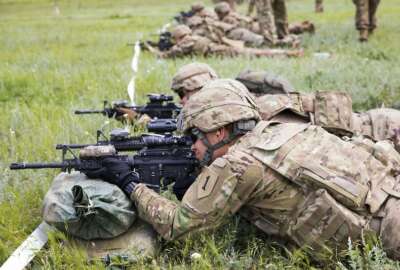
Military leaders prepare their case for divesting unneeded weapons systems
With the expectation of flat budgets over the next several years, each of the military services believes they'll need to divest themselves of at least some prog...
Best listening experience is on Chrome, Firefox or Safari. Subscribe to Federal Drive’s daily audio interviews on Apple Podcasts or PodcastOne.
It’s the time of year when the Defense Department’s top leadership gets ready to defend their annual budget proposal on Capitol Hill. But leaders of the military services say considering the flat budget, the only way they’ll be able to afford the long-term investments they need is to divest themselves of older weapons programs and spending plans.
And since those systems tend to have strong Congressional constituencies, they’re girding for a tough sell.
As part of their written 2021 budget submissions, the military services have already signaled their desire to end several of their “legacy” programs, and more are likely to come as part of the Pentagon’s latest cost-cutting drill. Defense Secretary Mark Esper recently told each of the services to conduct clean-sheet reviews of their spending, looking for ways to redirect funds toward the department’s top priorities in the National Defense Strategy.
Ryan McCarthy, the secretary of the Army, has some experience with this. As part of what the Army calls its “Night Court” process, it’s already cut $25 billion in spending on older systems, and plans to find another $10 billion in this year’s round of reviews. Lawmakers have already signaled some discomfort with the process.
“But you’ve got to have the will to look at Congress in the face and tell a member who has a product made in their district, ‘We don’t need it anymore, but here’s the opportunity that’s going to exist for that manufacturer if they play,’” McCarthy said Friday at a forum hosted by the Center for Strategic and International Studies. “It becomes a trust issue that you’ve got to build with the committees of jurisdiction first, and then the rest of the Congress. It requires consistency over time.”
McCarthy contends the Army has been consistent — it announced its six modernization priorities two years ago, and has stuck by them. But it became clear almost immediately that the Army couldn’t fund those new things without getting rid of old ones, particularly in a service whose budget is dominated by personnel and operational costs.
“When you have 40% or less of your budget to be able to modernize the force, the challenge is striking that balance between the new capabilities and divestiture. And divestiture is tough,” he said. “You’re going to cut legacy systems that have been in the formations for decades, and the question is when do you bring that off and will you be able to then flesh out the new capabilities over time?”
Read more: Defense News
And convincing Congress to invest in future capabilities gets even harder when there aren’t physical objects and assembly lines in individual Congressional districts to show for the effort. As part of its 2021 budget, the Air Force has indicated it wants to retire parts of its bomber and unmanned aerial vehicle fleets. And when it comes to the new investments it thinks are critical to the future, the outcomes are a bit less physically tangible, said Barbara Barrett, the Air Force secretary.
“It may not be associated with a constituency yet,” she said. “Things like connectivity between systems – those are invisible and harder to identify with. Similarly, space. It’s ubiquitous, but it’s invisible, and therefore a lot of people don’t appreciate how very engaged each of us are now with space. So the two key investments that we’ll be making that are maybe a bit out of our past patterns will be space and technology linkages. Both of those are harder to sell, because there aren’t tires to kick.”
In Navy’s case, the biggest investments officials think they need to make do have hulls to kick – but they’re likely to be smaller ones. In the next several days, the Navy and Marine Corps expect to release a new, jointly-developed force structure assessment.
Thomas Modly, the acting secretary of the Navy, said it will lay out how the Navy department will meet its existing goal of building a fleet of more than 350 ships. But at the CSIS forum, he signaled the composition of that fleet is likely to be very different from the one the Navy sails with today, focused on maximizing the Navy’s ability to deliver “presence” in as many areas as possible.
“It requires presence to secure sea lanes, to give assurances to our partners, and to also provide opportunities for us to exercise with our partners,” he said. “For a lot of these partners that we want in these regions, it’s difficult for them to go out and exercise with a carrier strike group. So it’s better for us to have smaller platforms that allow us to have much more constant interaction with them in a distributed maritime type of strategy. And that’s really what’s driving a lot of the changes that we’re looking at in our force structure … autonomous systems or lightly-manned or minimally manned systems are a part of what we’re looking at in terms of the future. We have to do a lot of experimentation with that, not just on the technical side, but how you actually fight with that. It’s a very new way of thinking for us.”
Modly said the Navy’s recent budgets have pushed it to concentrate too many of its procurement dollars into too few vessels. He says during the naval buildup of the 1980s, the budget was spread in such a way that each ship cost about $1 billion. Today, it’s more like $2 billion.
That’s part of the reason the Navy has launched its own take on the Army’s Night Court process — a “Stem to Stern” review seeking $40 billion in internal savings to fund more shipbuilding and digital modernization initiatives.
Read more: Navy News
Modly said there’s no reason to assume the Defense budget will keep growing, so the service needs a plan to fund the next buildup out of existing resources.
“We have a pretty big mandate to grow the fleet by 30, 40% from where it is today. And at some point, those elements of math are not going to match up,” he said. “So we support Secretary Esper’s requests for that. If there’s one thing that’s consistent over the last 40 years, it’s that the Navy’s percentage of the overall GDP has gone down consistently, as has the entire Defense budget.”
Copyright © 2024 Federal News Network. All rights reserved. This website is not intended for users located within the European Economic Area.
Jared Serbu is deputy editor of Federal News Network and reports on the Defense Department’s contracting, legislative, workforce and IT issues.
Follow @jserbuWFED






